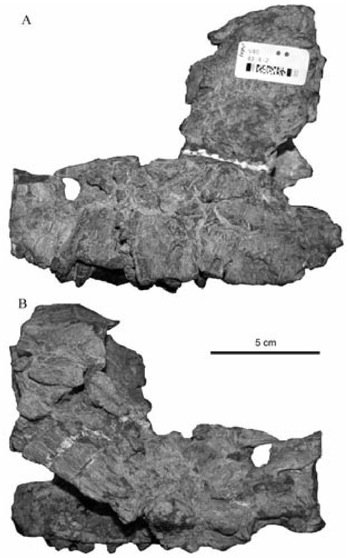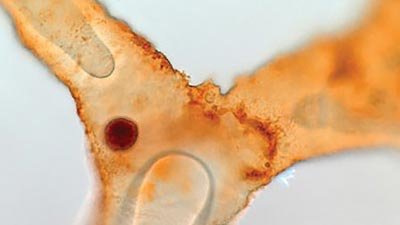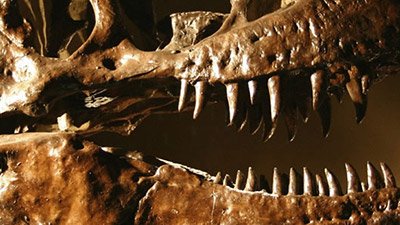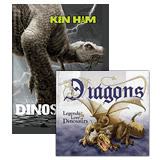
Choice of Timeline Determines Story
The Jurassic jawbone of a long extinct creature has resurfaced in China to add a new chapter to the saga of its mysterious identity.
News Source
- Smithsonian: “Pachysuchus Actually a Hidden Dinosaur”
In 1947 paleontologist Yang Zhongjian (aka C. C. Young) initially identified the “single badly damaged partial snout”1 as part of a sauropod dinosaur named Lufengosaurus magnus. However, Young later decided the bone belonged to a phytosaur, not a dinosaur, and renamed it Pachysuchus imperfectus. The fossil was found in early Jurassic deposits near Lufeng, China, but phytosaurs “should” have been extinct by the end of the Triassic era. Thus the fossil “became an important milestone for phytosaurs.” Somehow it then was misplaced in China’s Institute of Vertebrate Paleontology, hindering further investigation. Its recent re-discovery and re-re-identification as a dinosaur has restored the evolutionary version of dinosaur development to its commonly accepted form.
Phytosaurs, extinct crocodilian creatures distinguished by nasal openings set far back on the skull near the eyes, are currently classified as archosaurs, along with dinosaurs, crocodiles, and even birds. However, the archosaur branch containing phytosaurs has only one still-living representative, crocodiles. The phytosaurs are believed by evolutionists to be victims of the Permian-Triassic mass extinction, so discovery of Jurassic members is controversial.

Pachysuchus jaw fragment, viewed from the left (A) and the right (B). Image by XU Xing from Chinese Academy of Sciences.
Paleonotologists Paul Barrett and Xu Xing found the fragment and have determined Young’s original dinosaurian assessment was correct. “The damaged skull piece exhibits many traits never seen in phytosaurs but that closely match what paleontologists have documented among sauropodomorph dinosaurs,”2 Xu Xing says. Too little remains to determine the species.
The reclassification restores the story that phytosaurs “lived alongside and probably preyed on early dinosaurs, were wiped out at the end of the Triassic” and so were out of the way as “dinosaurs rose to global dominance.” In fact, Barrett suggests that rock layers containing post-Triassic phytosaurs elsewhere in the world are erroneously dated and should be re-dated as Triassic.3 (This illustrates the somewhat circular approach to assigning dates in the fossil record.)
While demonstrating the difficulties of identifying some creatures from their fossilized remains, putting Pachysuchus back to a more acceptable spot in the evolutionary timeline does not prove the authenticity of the evolutionary story. The geologic column is viewed by evolutionists as a record of the evolution and extinction of life forms over millions of years. This interpretation is dearly held despite the lack of the transitional forms to authenticate it or observable evidence of biological evolution of new kinds of creatures to show its feasibility.

Shape of the rediscovered Pachysuchus skull fragment is shown in grey, set into the outline of a typical sauropodomorph dinosaur skull. Image by R. Laws from Chinese Academy of Sciences.
The biblical account of the global Flood—resulting in catastrophic burial of billions of creatures beneath tons of water-borne sediment as their habitats were wiped out—tells the true story of most of the geologic column. The creatures buried were descended from the kinds created by God in the beginning. Their presence in those rock layers does not mark their evolutionary emergence or extinction. A person’s worldview determines his interpretation of the story in the rocks.
Further Reading
For More Information: Get Answers
Remember, if you see a news story that might merit some attention, let us know about it! (Note: if the story originates from the Associated Press, FOX News, MSNBC, the New York Times, or another major national media outlet, we will most likely have already heard about it.) And thanks to all of our readers who have submitted great news tips to us. If you didn’t catch all the latest News to Know, why not take a look to see what you’ve missed?
(Please note that links will take you directly to the source. Answers in Genesis is not responsible for content on the websites to which we refer. For more information, please see our Privacy Policy.)
Footnotes
- “New Study Turns Pachysuchus A Hidden Dinosaur - Removing Only Post-Triassic Record of Phytosaurs from Asia,” Chinese Acadmey of Sciences, April 28, 2012, http://english.cas.cn/resources/archive/research_archive/rp2012/201502/t20150217_143603.shtml.
- Ibid.
- Ibid.
Recommended Resources

Answers in Genesis is an apologetics ministry, dedicated to helping Christians defend their faith and proclaim the good news of Jesus Christ.
- Customer Service 800.778.3390
- © 2024 Answers in Genesis







